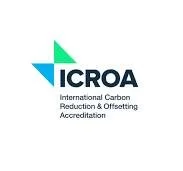From pollutant to building material - we create living space from CO₂
We bind CO₂ in houses. We also create certified CO₂ sinks and follow the Global Construction C-Sink Standard for maximum climate effectiveness.
CO₂ sink certification
Developed by the Ithaka Institute and published by Carbon Standards International, the Global Construction C-Sink Standard provides options for carbon dioxide removal (CDR) and climate protection through construction.
The standard is based on the latest Carbon Removals and Carbon Farming (CRCF) Regulation of the European Union (EU/2024/3012) and is ICROA endorsed.
Certification process according to the Global Construction C-Sink Standard
-
Biomass carbon (e.g. Hempcrete) is tracked from cultivation to the construction site using digital dMRV systems.
-
All greenhouse gas emissions (cultivation, transportation, processing) are recorded in an emissions portfolio and offset with geological (CO₂, N₂O) or temporary (CH₄) carbon sinks.
-
After verification by certified C-sink managers and accredited certifiers, the C-sink is entered in the Global Carbon Register.
-
Annual checks ensure the integrity of the temporary C-sink (e.g. 60 years).
Europe's largest hemp building (OPENLY Valley Widnau) - built with our technology.
CO₂ compensation and certificate trading: Certified Hempcrete buildings open up lucrative opportunities for CO₂ compensation and additional income. Thanks to our partnership with myclimate.org, we can compensate building owners 85 euros per ton of CO2 (approx. 10m3 Hempcrete = 1 t CO2).
With the eco-friendly appeal of Hempcrete, you can position your project as a sustainability leader, attract green investors and increase real estate value in a sustainability-conscious market.
Biogenic building cost subsidies
CANCRET for your construction project:
A conventional timber frame construction is planned and put out to tender. These elements are poured horizontally at the locally selected timber constructor using the Hempcrete mixer and mobile mixing plant patented by CANCRET. Around 50m2 can be produced per day.
The highlight: the mixing plant comes to the element and the added value remains with the timber manufacturer. This strengthens the ecosystem and reduces transportation routes.
Alternatively, we offer production at our production facility in Nenzing AG.
→ Contact us for a non-binding consultation.
Our production in Nenzing AT (Lake Constance)






